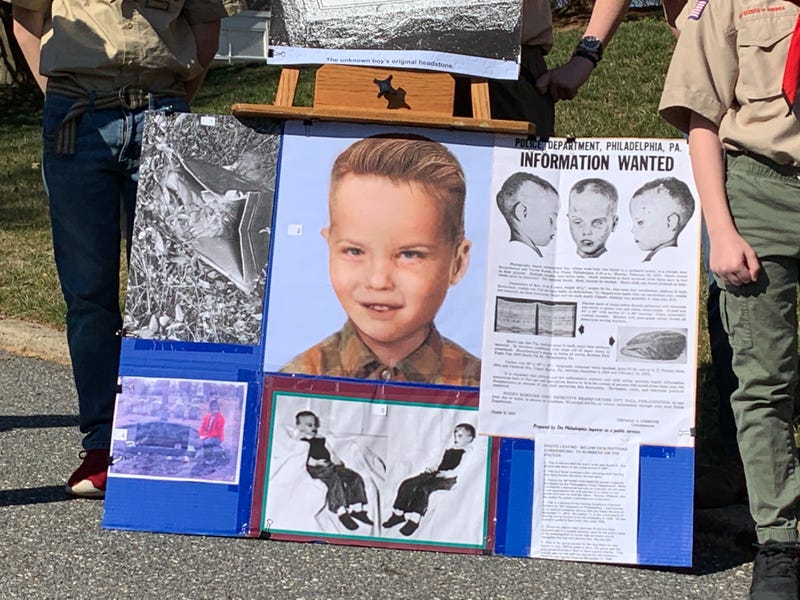
PHILADELPHIA (KYW Newsradio) — Joseph Augustus Zarelli. That is the name of the boy found dead inside a cardboard box 65 years ago in Northeast Philadelphia.
Police announced his name during a press conference Thursday, bringing closure for some who have been involved in over six decades of investigations, analysis, and genealogy studies with the help of international experts.
It also finally begins the next phase of the investigation into his death. Police say they hope the announcement of the boy’s name helps the public refresh memories and bring in tips.
Sixty-five years of investigating came down to DNA analysis and genealogy. Police Commissioner Danielle Outlaw credited all the investigators whose work led to this point.
“Without the hard work, dedication and passion and the doggedness of the many, we would not be here today to give America's formerly Unknown Child, Joseph Augustus Zarelli,” said Outlaw.
The finding was decades in the making. Philadelphia Homicide Captain Jason Smith says the boy had just turned 4 years old, and was from West Philadelphia, around 61st and Market streets.
“In homicide cases such as this, extreme difficulty lies in the fact that rarely can they be resolved and the offender ultimately brought to justice, until the victim is first identified,” said Smith.
'A traumatic experience'
The child was found dead on Feb. 25, 1957, nude and wrapped in a green blanket, with bruises and scrapes all over his body and distinct scars on his heel, chin, and groin.
Philadelphia police officer Elmer Palmer, who has since died, was the first officer to arrive at the scene along Susquehanna Road near Veree Road in Northeast Philadelphia.
Related: Son of first officer on the scene in 1957
“They followed procedures. Officers found it. They contacted detectives. Detectives came up and took it from there. The medical examiner came up. All those people back then, they just hung onto it to figure out what happened,” said Jim Palmer, Elmer’s son.
“It was a traumatic experience for him, for all of them.”
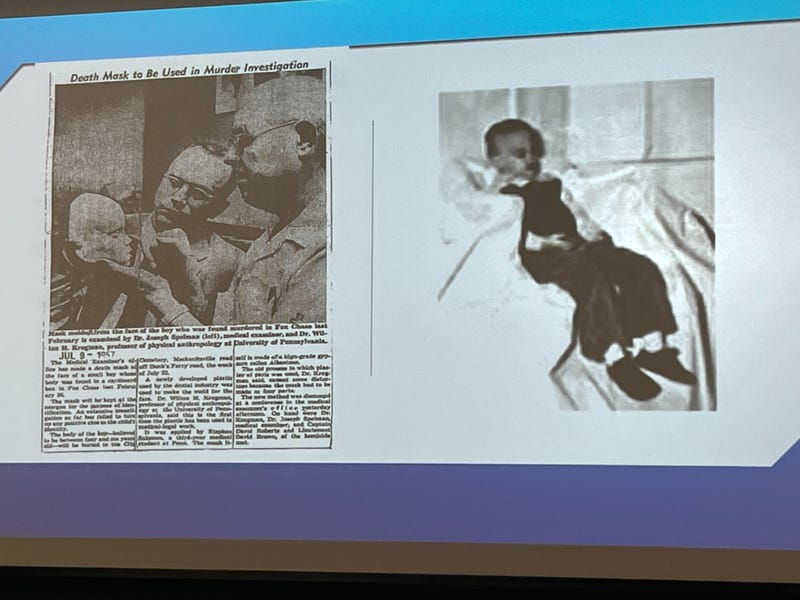
Detectives door-knocked for weeks asking about who this little boy belonged to, but with no luck. Then-Police Commissioner Thomas Gibbons Sr. made the controversial decision to put a picture of the dead child on a poster.
“Some of the other pictures that had been published just break your heart,” said Jim Palmer.
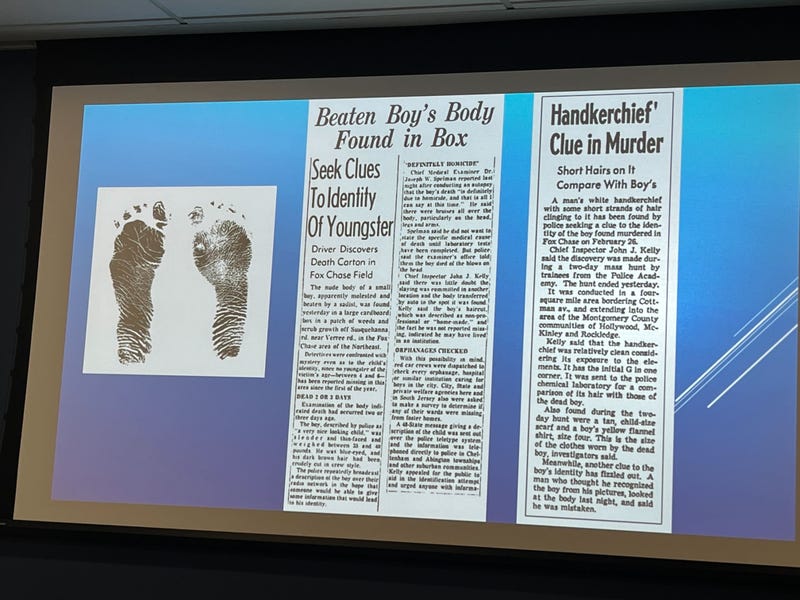
Weeks and months turned into years and decades, with hundreds of investigators not only trying to identify the child, but also symbolically adopting him as their own. The investigation was etched into the community’s memories.
“It's interesting to me to see comments people put. ‘I remember this from when I was a kid and how it scared me,’” Jim Palmer added. “It’s a shame that so many people had to feel so bad … because they couldn’t figure out what was going on.”
'The most challenging case of my career'
Over the years, his body was exhumed three times: once for re-burial, and the most recent in 2019 to get new DNA samples to build a full profile. Investigators handed it over to genealogist Colleen Fitzpatrick to build a family tree.
“This was the most challenging case of my career,” said Fitzpatrick, founder and president of Identifinders International.
“It took 2 1/2 years to get the DNA in shape — it was so bad — to get to the point where we could create snip data that we could use for genealogy.”
Related: DNA analysis, genealogy held the key
The genetic profile was uploaded to databases and then interpreted by several experts.
“Our success was a cooperation among experts from several countries,” she said.
Fitzpatrick and other genealogists used the DNA profile to build a family tree. Detectives were able to track down the birth mother’s identity on records with her name on them.
“One of whom provided DNA and was matched previously by the genealogists,” said Smith.
“The third result was a birth certificate for a male child born to the established birth mother in 1953 which could be consistent to the approximate age of the unidentified child.”
Smith says the birth father was also listed on that certificate, and they will not reveal either parent's name, to keep privacy for family members.
“Joseph has a number of siblings on both the mother and father’s side who are living,” said Smith, who said they recently brought in a family member for an interview.
Investigators are working through the family tree to find any others who remember the child.
They hope someone will recognize Zarelli’s picture and name, and come forward with any information or memory of the little boy.
“I am hopeful that there’s somebody who was in their mid-to-late 70s, possibly their 80s, who remembers that child,” said Smith.
“We have our suspicions as to who may be responsible, but it would be irresponsible for me to share these suspicions as this remains an active and ongoing investigation.”
Investigators move ahead; others find closure
Former investigators, families, the genealogists from Philadelphia and outside America, and many others who endured the emotions of awaiting answers can finally take steps to move forward.
Vidocq Society members, who buried the boy in Ivy Hill Cemetery, will now work to etch the child’s name in stone.
Related podcast

“He will no longer be the ‘Boy in the Box,’” said Bill Fleisher, a former Philadelphia police officer and FBI agent who now leads the Vidocq Society, which started more than 30 years ago to get law enforcement and others together to help solve cold cases.
“He has a name, and I was raised to believe that when you say the name out loud of a loved one, that person still lives in spirit amongst us. Soon with the good offices of Mr. Dave Drysdale and his team at the Ivy Hill Cemetery, the Vidocq Society will put a name on that child’s grave.”
Part of the ‘Boy in the Box’ legacy will be how genealogists working the case fought to find his identity, and forged new methods in the process which in turn will help other families and communities identify their loved ones.
“The technology that we pushed forward is giving hope to other unidentified whose DNA is thought to be beyond the modern horizon of technology,” said Fitzpatrick. “Maybe it isn’t after all.”
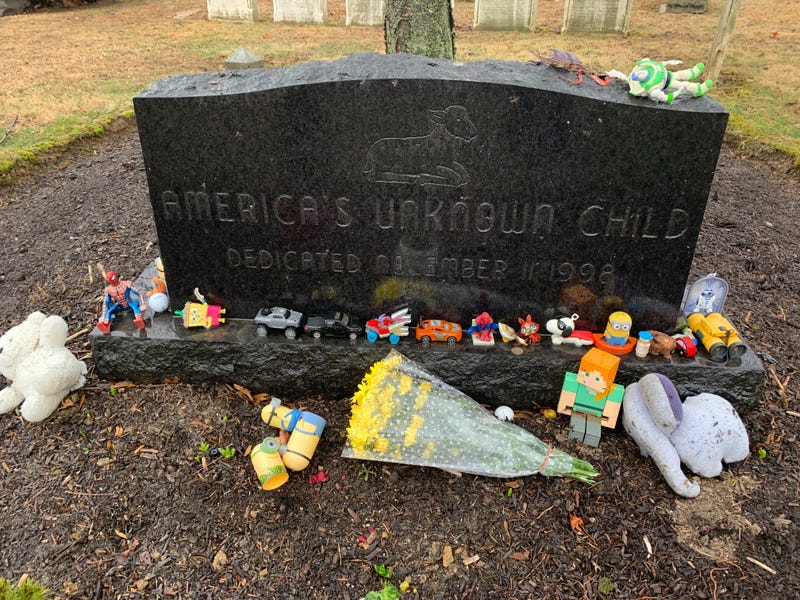
Fitzpatrick said that even though Zarelli can never be brought back, his name finally being spoken in one way brings him alive again.
“I’m just relieved., I’m happy. I’m just almost ready to cry,” she said.
“Now we are going to go out to his grave and bring him some toys to say hello. Pay him my regards and say we are happy for him.”
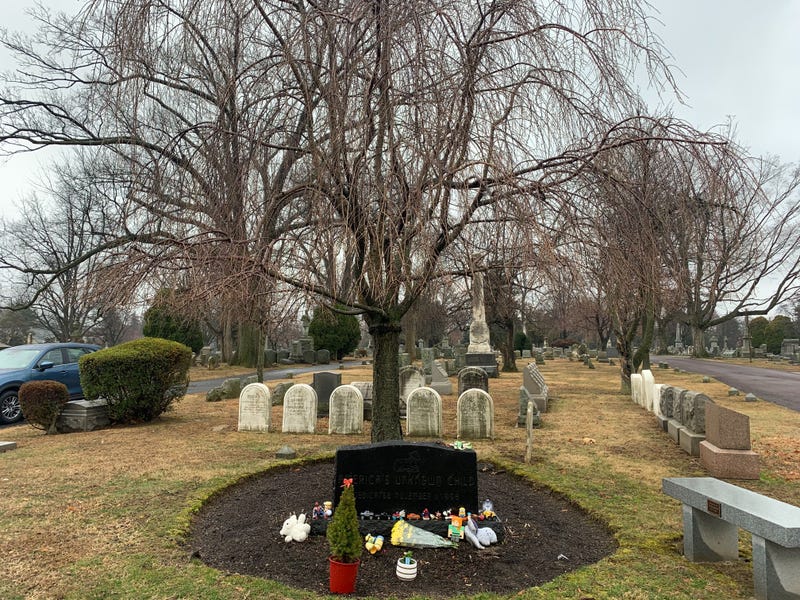
As some head to little Joseph’s grave to remember him, Jim Palmer says a part of his father Elmer’s mission is finally complete, years after his own death.
“It stayed with him his whole life,” Jim said, adding his father would breathe a sigh of relief.
“This is very cathartic, not just for me, but for people in the neighborhood who were here then, for kids growing up, and especially for the officers who have been involved all these years. I hope it's cathartic and people find peace from it.”

